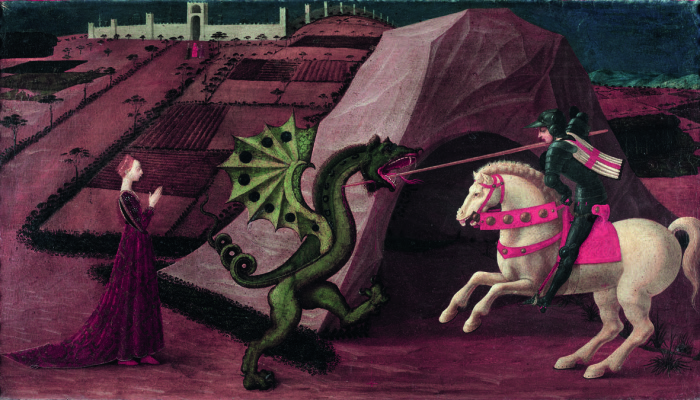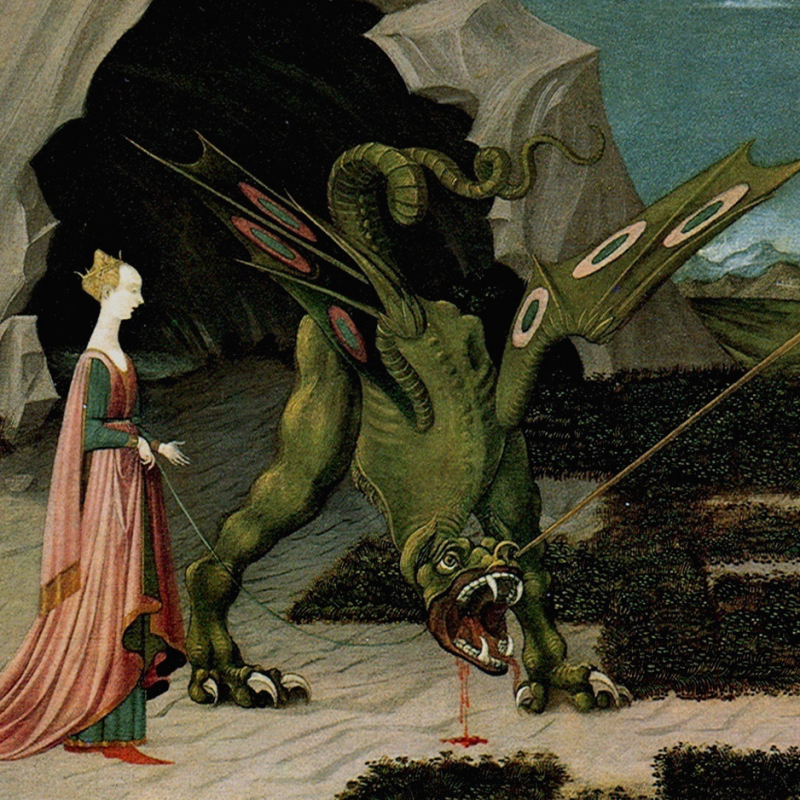
San Giorgio e il drago Paolo Uccello a Londra
In the early Renaissance, Paolo Uccello created one of the most enigmatic and fascinating works of art in the history of art: ‘Saint George and the Dragon’. This masterpiece, created in two versions, is not only the representation of a legendary clash, but a symbolic journey into the conflict between Christianity and paganism, between peace and war, between the visible world and the hidden world of alchemical symbols and occult philosophy.
Immersed in a dreamlike and mysterious atmosphere, the details of the painting reveal a profound and complex narrative, full of meanings and questions. In this post, I take you on a journey to discover the secrets behind Paolo Uccello’s brushstrokes, in a work that continues to enchant and provoke reflection.
SAINT GEORGE AND THE DRAGON BY PAOLO UCCELLO

Paolo Uccello, San Giorgio e il drago, c. 1458-60. Parigi, Musée Jacquemart-André. Image source: http://www.studioesseci.net
Paolo Uccello reached the highest point of his creativity, inspired by fairy-tale medieval images, in ‘Saint George and the Dragon’.
The artist produced two versions of the same subject: one exhibited at the National Gallery in London, the other at the Musée Jacquemart-André in Paris.
The work conserved in London is immersed in a magical and dreamlike atmosphere, in which certain enigmatic elements appear, such as the spiral of clouds on the right or the strange position of the grass, the interpretation of which is probably to be sought in the context of the alchemic culture and occult philosophy present in the aristocratic and bourgeois society of the Renaissance.
ANALYSIS AND DESCRIPTION OF SAN GIORGIO E IL DRAGO BY PAOLO UCCELLO
In the painting, St. George is seen striking the dragon, which is, however, held on a leash by the princess. It is a scene that is not immediately comprehensible because it is not clear how a dragon can be tamed and at the same time be suppressed by St. George’s violence. Since he is on a leash, he should in fact pose no danger.
Yet he is struck down and one can see the suffering of the dragon now doomed to death.
St George is traditionally the protector of Christianity, while the dragon is the symbol of paganism. Therefore Paul Bird creates a work in which he describes the clash between two religions and points out two possible ways.
St. George and the dragon therefore does not describe an event but is a highly symbolic work and indicates the alternative between two courses of action in relation to the political situation at the time: whether to find a peaceful way forward in relations with the East, or whether to take up arms against the religious military danger that is about to manifest itself.

This masterpiece invites us to reflect on the choices and tensions of the time, representing an eternal dialogue between the sacred and the profane, between peace and conflict. If you want to learn more about Paolo Uccello’s work and his extraordinary ability to combine history and symbolism, his series of paintings entitled ‘The Battle of San Romano‘ is also not to be missed.
“Paolo Uccello’s ‘Saint George and the Dragon’ is not just a painting, but a bridge to a world of symbols and meanings that transcend time. The two versions of the work, housed in London and Paris, continue to arouse admiration and curiosity, offering a fascinating insight into the complexity of the Renaissance mind and Uccello’s unique vision.

